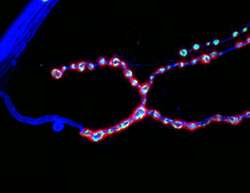Scientists identify important regulator for synapse stability and plasticity

(Medical Xpress)—Using the fruit fly as a model organism, neurobiologists from the Friedrich Miescher Institute for Biomedical Research have identified the L1-type CAM neuroglian as an important regulator for synapse growth, function and stability. They show that the interaction of neuroglian with ankyrin provides a regulatory module to locally control synaptic connectivity and function.
From its earliest beginnings until an organism's death, the nervous system changes. Connections between nerve cells are formed, stabilized and disassembled not only during the development of the brain in the womb and in early childhood, but also in adults as they learn or form memories. In this flow of change, cell adhesion molecules (CAMs), which mediate cell-cell interactions, are thought to provide stability and guidance in a Velcro-like-manner as synapses change.
Jan Pielage and his group at the Friedrich Miescher Institute for Biomedical Research have carried out an unbiased genetic screen to identify cell adhesion molecules that control synapse maintenance and plasticity, using the fruit fly, Drosophila. As they publish in the latest issue of PLOS Biology, they identified the cell adhesion molecule called neuroglian as a key regulator for synapse stability.
Neuroglian is a transmembrane protein with a large extracellular domain and an intracellular signaling domain. Through the extracellular domain interactions with CAMs on neighboring cells are established. This stabilizes the site and is a prerequisite for synapse formation. "We think that the extracellular interactions of neuroglian are essential for neurite outgrowth and axon targeting during early development," explains Pielage.
The scientists could then show that the intracellular domain, which interacts with the adaptor molecule called ankyrin, modulates the stability of synapses. At the neuromuscular junction, where nerve cells innervate the muscle, the strength of the interaction of neuroglian with ankyrin modulates the balance between synapse growth and stability. As the binding affinity of ankyrin for neuroglian decreased, e.g. due to phosphorylation, the mobility of neuroglian within the motorneuron increased. This change in mobility caused the destabilization of synapses but at the same time, it allowed the formation of new synapses at other places. "This organization permits easy regulation, and allows the fine tuning of synaptic connectivity along one nerve cell without disrupting the neuronal network or impairing overall circuit stability," said Pielage.
In the central nervous system, where synapses are formed between two neurons, a homophilic interaction of neuroglian is required to establish the contact between pre- and postsynaptic neurons. A differential regulation of ankyrin binding is then necessary to coordinate transsynaptic development and to enable synapse maturation and function. "Modulation of the neuroglian-ankyrin interaction might enable local and precise control of synaptic connectivity," comments Pielage.
This comprehensive structure function study provides a molecular basis for previous observations linking mutations in the ankyrin binding domain of the human homologue of neuroglian, L1CAM, to neurological L1/CRASH disorders that include mental retardation.
More information: Enneking, E. et al. (2013) Transsynaptic coordination of synaptic growth, function, and stability by the L1-type CAM neuroglian. PLOS Biology, 11: e1001537. www.plosbiology.org/article/info%3Adoi%2F10.1371%2Fjournal.pbio.1001537
















